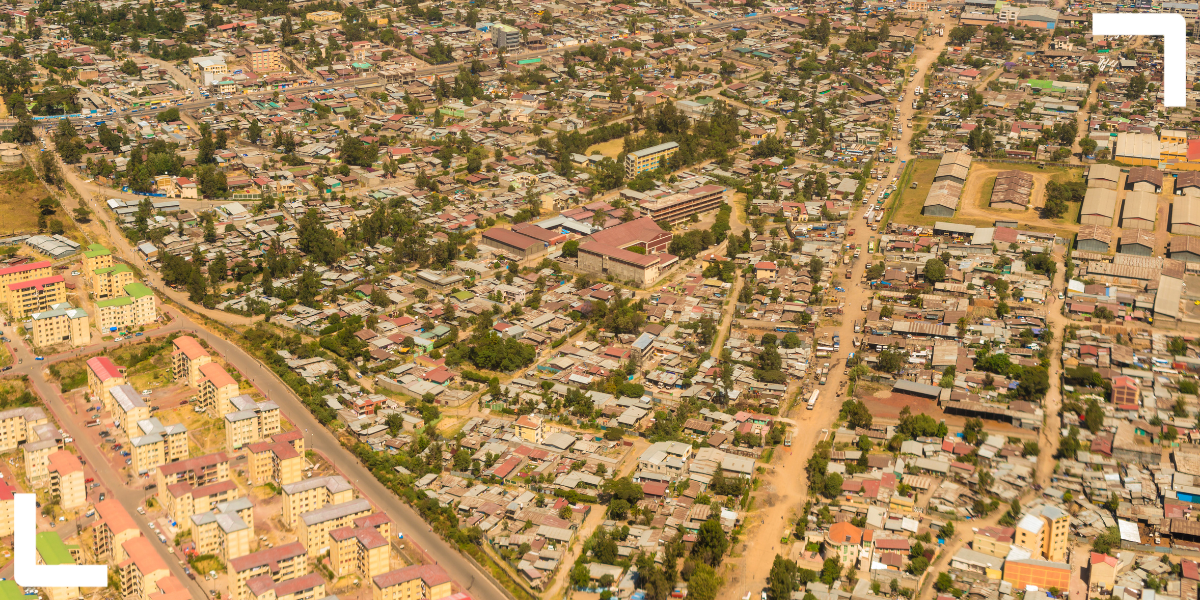Home to a population of more than 4 million, Addis Ababa is expanding at a rate of 3.8% per year. A new ACRC report, led by Tegegne Gebre-Egziabher, uncovers the interplay of politics, systems and urban development in the fast-growing capital city, shining a light on the challenges facing residents and potential pathways forward.
Bringing together analysis from research reports on political settlements and city systems, along with studies on the domains of housing, structural transformation and youth and capability development, this report presents an overview of Addis Ababa’s complex and contested urban development landscape. It highlights pertinent development challenges facing the city – particularly its low-income communities – and presents potential interventions to address them.
Political settlement
As the seat of the Ethiopian national government, Addis Ababa is the country’s political, economic and industrial centre, and also houses the headquarters of the African Union and the UN Economic Commission for Africa. The national-level political settlement has a significant influence over how the city is run, with the Prosperity Party (PP) in particular influencing major decisions and development projects.
As the capital of both the federal state and the Oromia region, Addis is also highly contested. Being surrounded by the Oromia regional state, the city’s geographic expansion also creates tensions between different state authorities.
Fragmented city systems
In terms of regulatory institutions, services, actors and ownership regimes, Addis Ababa’s city systems are fragmented and lack integration. Formal and informal systems tend to operate separately, but there are inevitable linkages between them.
Services provided often remain unaffordable for low-income residents, or do not reach the areas where these communities live. The exclusion of informal settlements in particular exacerbates health, education and income inequalities in the city.
Prevalent informality and inequality
Across the domains studied, informality and inequality were found to be prevalent. In the face of high demands, there is a huge backlog in the provision of housing. This forces many low-income households to acquire land and property informally, usually in the city’s peripheries – leading to tenure insecurity and poor living conditions, and heightening socioeconomic inequality.
Informal housing construction in these areas is usually undertaken in an incremental manner due to limited construction finance and an absence of basic infrastructure, including roads and utility lines for water and electricity.
In the youth and capability development domain, different narratives were found to influence government policy attitudes towards young people. Comprising around 31% of Addis Ababa’s population, young people are a vital social group in shaping ruling elites’ socioeconomic and political decisions. As such, they are also targeted by political elites to secure votes through the provision of rents.
Youth unemployment is a key issue in the city, with an estimated 30% of young people aged between 15-29 out of work. Meanwhile, working conditions for those who are employed in industrial parks tend to be shaped by the interests of global capital, while the informal labour market, in which many young people seek a living, is characterised by a lack of policy coherence and consistency.
Where structural transformation is concerned, most micro and small enterprises in Addis Ababa are not experiencing dynamic growth, while middle and large enterprises show mixed patterns of growth. Formal governance of structural transformation tends to be dominated by federal government institutions, while informal governance is largely influenced by the interaction of the political settlement with business interests.
While a lack of enterprise growth is a key challenge in terms of job creation in the city, business closure is also a significant problem, with lack of finance reported as the main reason for firms shutting down.
Mapping a way forward
As well as highlighting deficiencies and challenges facing Addis Ababa and its residents, the report identifies a number of potential interventions across systems and domains that could help pave a way forward. These include:
> Coordination and integration – Problems in one system can lead to inadequate service delivery in another, and there is a lack of coordination among different sectors working on the same issue. The city government therefore needs to establish mechanisms of coordination across sectors and bureaus to improve the efficiency and effectiveness of key services.
> Improving youth agency – Although young people have demographic and political significance in the city, they lack organisational and political power. This results in limited capacity to address the problems they are facing, such as in the formal and informal labour market, and in accessing services and housing. Young people need to be empowered through facilitating youth platforms, so they can exercise agency in advancing their interests.
> Enabling job-rich city development – The demand for jobs in Addis Ababa is very high, largely due to increasing migration, as the city is deemed by many to have economic and social opportunities. This means that the city has one of the country’s highest unemployment rates, especially among young people. Accelerating structural transformation through necessary support for enterprises should therefore be a priority to help create new jobs.
Header photo credit: helovi / Getty Images (via Canva Pro). Aerial view of Addis Ababa.
Note: This article presents the views of the authors featured and does not necessarily represent the views of the African Cities Research Consortium as a whole.
The African Cities blog is licensed under Creative Commons Attribution-NonCommercial-NoDerivatives 4.0 International (CC BY-NC-ND 4.0), which means you are welcome to repost this content as long as you provide full credit and a link to this original post.


